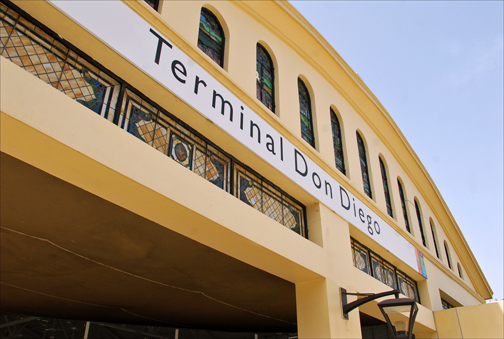DR could hit 10M visitors a year by ’22 if growth holds


Don Diego cruise ship terminal in the colonial zone of Santo Domingo, capital of the Dominican Republic. (Credit: Larry Luxner)
The Dominican Republic is on track to meet or exceed President Danilo Medina’s goal of welcoming 10 million visitors annually by 2022 — solidifying its status as the undisputed leader in Caribbean mass-market tourism.
By last November, non-resident travel to the DR for 2015 broke the 5-million mark, up 8.9 percent from the first 11 months of 2014 and ending the year at around 5.6 million. In January 2016 alone, arrivals came to 584,755 — up by 37,000 or about 7 percent compared to a year earlier, and an increase of more than 100,000 from the 472,102 tourists who visited in January 2013.
Tourism Minister Francisco Javier García said the industry is enjoying its best performance in 40 years, with tourism contributing $6 billion annually to the Dominican economy. At last count, 51.7 percent of all visitors arrived from the United States, Canada and Mexico; 27 percent from Europe, 16.4 percent from South America, 4.5 percent from Central America and the Caribbean, and 0.4 percent from Asia and elsewhere.
The single largest jump appears to be from economically bankrupt Venezuela, many of whose people are looking to relocate — possibly to the DR. In November 2015, the country received 11,220 additional Venezuelan visitors, even more than the additional 10,816 Americans who came that month.
This year, the country’s north coast alone will receive 1.3 million tourists, according to Julio Almonte, the deputy tourism minister for Puerto Plata. He told local media that 500,000 will arrive by air, another 350,000 aboard cruise ships calling at the new Amber Cove cruise ship port, and 400,000 overland. Another regional official, Máximo Iglesias, predicted a 10 percent increase in travel to the north coast this year.
As in past years, the DR’s main point of entry remains Punta Cana International Airport (PUJ), accounting for a whopping 66.2 percent of all air arrivals in 2015. Following PUJ in importance was Santo Domingo’s Las Américas International Airport with 18.7 percent and Puerto Plata with 7.6 percent.
Frank Rainieri, CEO of Grupo Puntacana — which runs PUJ — said that after Holy Week 2016, his company will begin construction of a third terminal, which will have the capacity to handle 2.5 million passengers a year. That’s in addition to the airport’s Terminal B, a closed 22,000-square-meter building on two floors with 50 check-in desks, seven air bridges and nine boarding gates.
Terminal B, which can handle 23 aircraft simultaneously, represented a $100 million investment at PUJ, which already ranks as Latin America’s ninth-largest airport in passenger volume. It’s unclear how much the third terminal at PUJ will cost.
Later this year, as construction proceeds on this latest expansion, the airport will receive the DR’s first-ever nonstop flights from the Middle East.
Alexander de la Rosa, the Dominican ambassador to Israel, said that in October, El Al will launch charter flights from Tel Aviv to PUJ every 13 days, with the operation evolving into a weekly flight. El Al will carry up to 277 passengers on a Boeing 777; the airline is targeting mainly Dominicans interested in Christian pilgrimages to the Holy Land through local companies such as Mona Tours and Genesis Tours, as well as Israeli backpackers in search of a new Caribbean budget travel destination.
Rainieri added that a related project, Blue Mall Punta Cana, is on track for completion later this year.
The mall, which bills itself as “the largest and most modern shopping center on the east coast” of the country, is a joint venture between Grupo Puntacana and Grupo Velutini. Although construction of the $40 million mall was supposed to begin in 2010, the global economic crisis forced its backers to hold off.
But now it’s back on track.
Based on the model of Blue Mall Santo Domingo, the complex will boast shops selling luxury labels such as Louis Vuitton, Burberry, Ralph Lauren, Gucci, Lacosta and Oscar de la Renta — as well as less expensive options like Zara, Benetton, Liz Claiborne and Nine West.
“God willing, in September we will be inaugurating the first 148 shops, which will generate more than 2,000 jobs,” said Rainieri, adding that the lushly landscaped 50,000-square-meter mall will have 20 two-story buildings featuring local coral rock, wood beams and glass, as well as movie theaters and restaurants.
An even more ambitious project to attract tourists is already in operation along the country’s north coast. Amber Cove, the DR’s newest cruise port, is likely to receive 350,000 passengers in 2016, according to David Candib, vice-president of development and operations at Miami-based Carnival Corp. By comparison, last year a total 549,000 passengers at all of the DR’s cruise terminals: Santo Domingo, La Romana, Samaná and Puerto Plata.
During the 2014-15 cruise season, the 407,100 transit passengers who visited the DR on cruise ships spent a total of $25.6 million. Another 73,528 arrived in the DR to begin their cruise, according to the FCCA, spending $6.3 million, or an average $85.94 per passenger in both categories.
Candib, speaking at a recent National Shippers Association luncheon in Santo Domingo, said eight cruise lines would bring tourists from the UK, Germany, Italy and the United States, and that the $90 million
Amber Cove represents the most money Carnival has ever invested in a cruise terminal. So far this year, more than 40,000 visitors have passed through the complex in Puerto Plata’s Maimon Bay. By 2020, he predicted, Amber Cove — which can accommodate up to 8,000 passengers and 2,000 crew members at the same time — could be receiving 500,000 to a million visitors annually.









